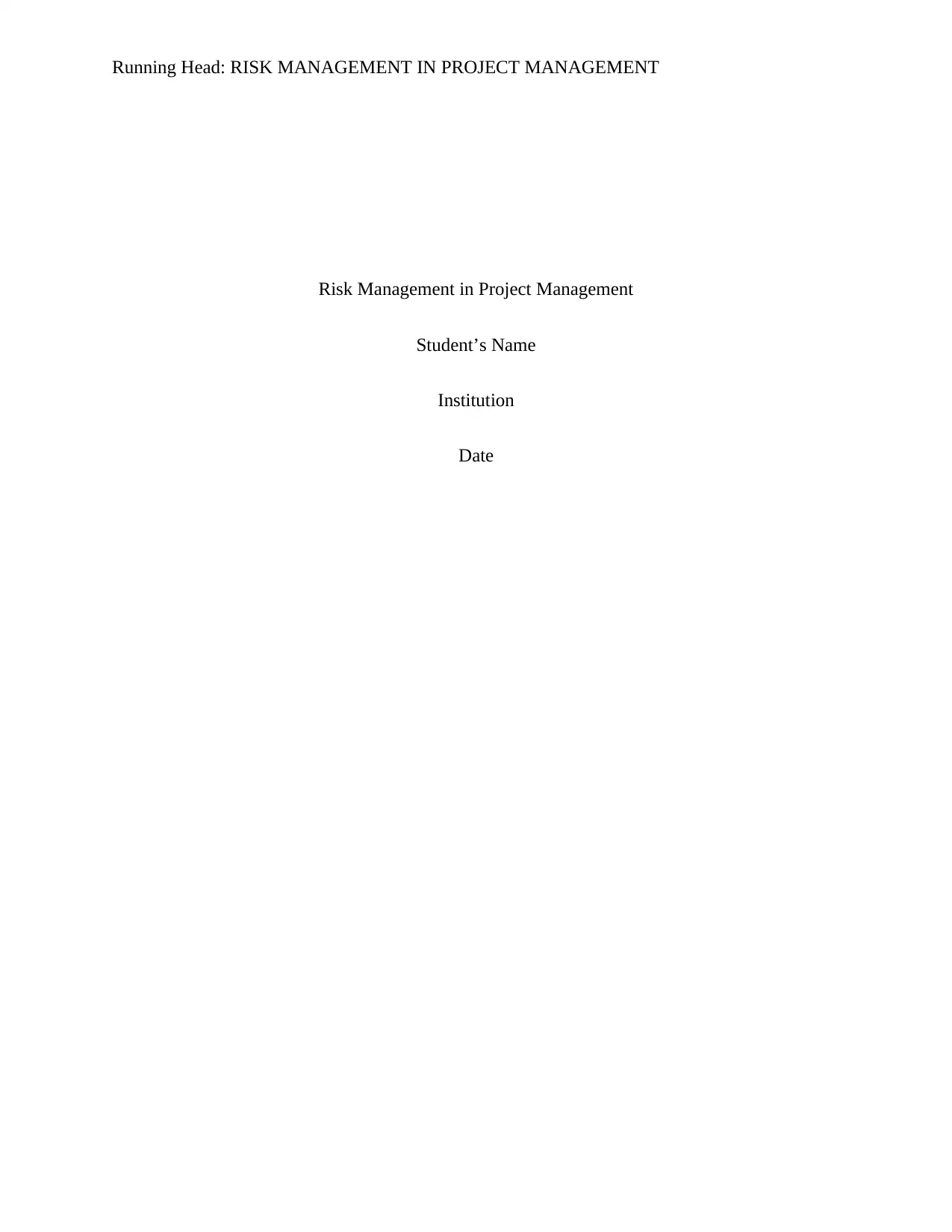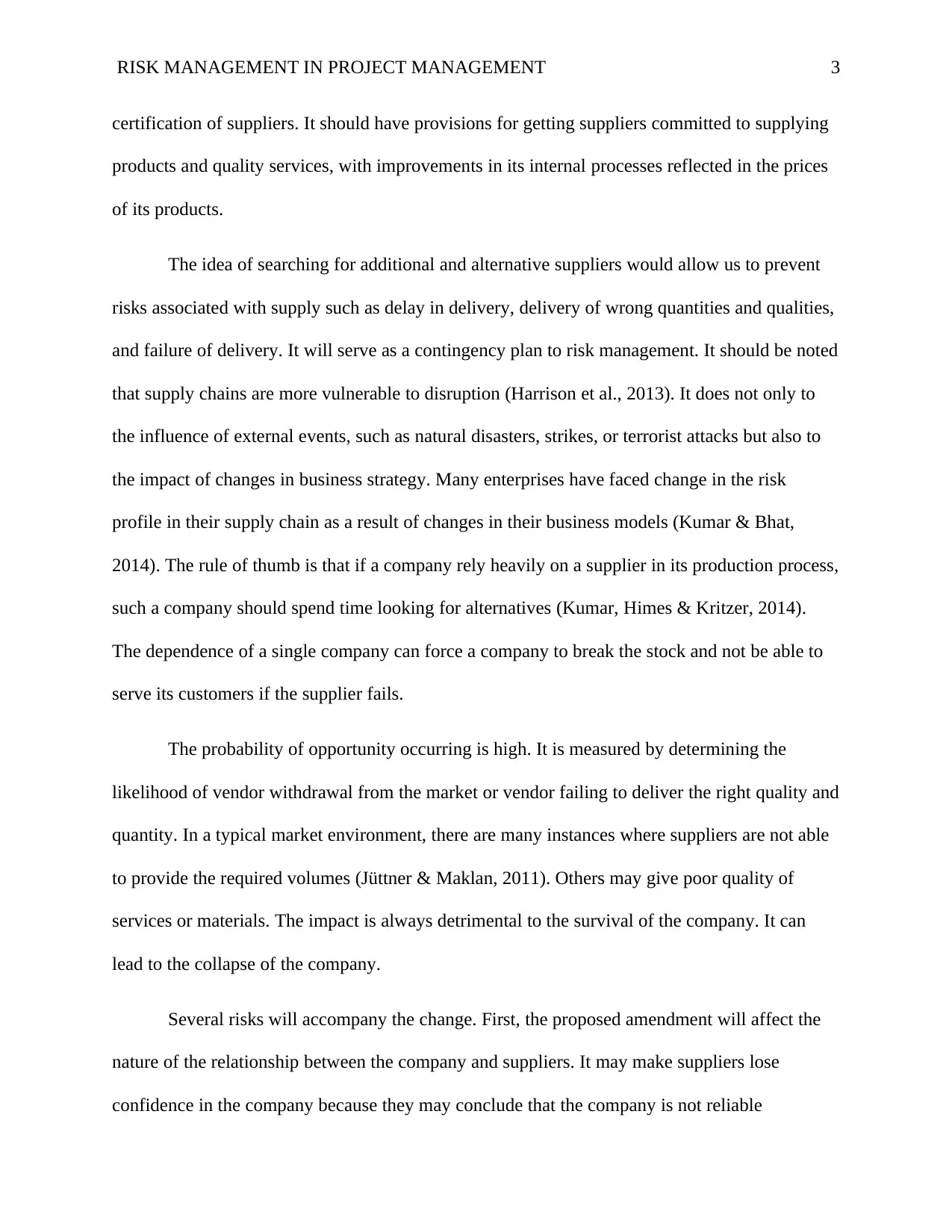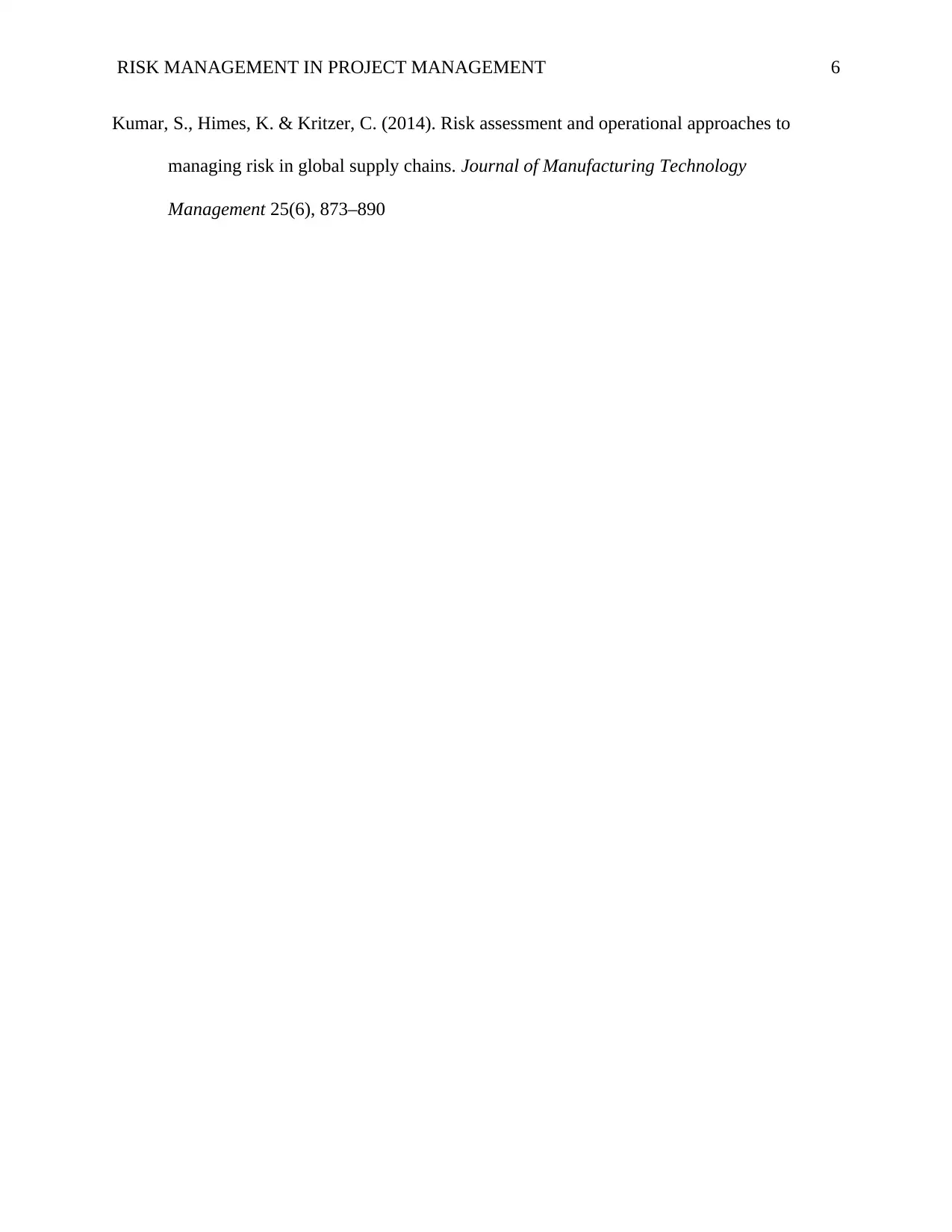Project Risk Management: Identifying Risks and Mitigation Strategies
VerifiedAdded on 2022/12/23
|6
|1235
|36
Report
AI Summary
This report delves into the critical aspects of risk management within the context of project management, specifically focusing on procurement-related risks. The analysis begins by identifying opportunities to mitigate potential risks, such as searching for alternative suppliers to reduce dependency and ensure supply chain resilience. The report emphasizes the importance of supplier analysis, highlighting the significance of having backup suppliers, particularly for critical materials or services. It then evaluates the probability of these opportunities occurring, acknowledging the vulnerability of supply chains to disruptions. The report also examines the risks introduced by the proposed changes, such as potential impacts on supplier relationships and standardization. Finally, it outlines a communication plan involving contract documents to prevent miscommunication and reduce conflicts, thus providing a comprehensive approach to risk management in project procurement.

Running Head: RISK MANAGEMENT IN PROJECT MANAGEMENT
Risk Management in Project Management
Student’s Name
Institution
Date
Risk Management in Project Management
Student’s Name
Institution
Date
Paraphrase This Document
Need a fresh take? Get an instant paraphrase of this document with our AI Paraphraser

RISK MANAGEMENT IN PROJECT MANAGEMENT 2
The risk management in the procurement context are those processes of identification,
assessment, and control of risks arising from the procurement tasks. Based on the case provided,
several changes ought to be made to prevent or mitigate the possible risks that may occur. The
paper will answer some questions related to risk management. First, it will identify the changes
that will be made to create an opportunity. Second, it will describe the opportunity and evaluate
the probability of possibility occurring. Third, it will identify the risk introduced by change, and
the communication plan to be adopted.
To create an opportunity, I will search for additional and alternative suppliers to reduce
risks associated with the supply of prototypes. One way of managing supplier risks involves the
search for alternative suppliers. From valuation practice, dependence on key suppliers
undoubtedly affects the value of the company, since it is assessed as a risk factor (Hofmann et al.
2014). The first thing towards searching for alternative suppliers is to do ABC supplier analysis.
It should be noted that type A suppliers are those that provide us with raw materials or services
without which, it would be impossible to develop our main activity (Jung, Lim & Oh 2011).
Besides, a failure in products or services, including a supply problem, could be critical (defining
critical in the way that best suits the degree of risk aversion of the person responsible, such as
damage to the final patient, a deterioration in the image of the company, an economic impact,
etc.) On this type of suppliers, I recommend, as long as possible, to have an alternative provider
and keep it active, that is, to make at least a couple of purchases a year. In this way, we will
make sure we have a "plan B" in the face of a problem from our primary vendor. Then,
companies must implement a whole supplier development program that includes selection
processes, periodic performance evaluation, evaluation of the quality management system
(Agigi, Niemann & Kotzé, 2016). The plan should also cover monitoring, accompaniment, and
The risk management in the procurement context are those processes of identification,
assessment, and control of risks arising from the procurement tasks. Based on the case provided,
several changes ought to be made to prevent or mitigate the possible risks that may occur. The
paper will answer some questions related to risk management. First, it will identify the changes
that will be made to create an opportunity. Second, it will describe the opportunity and evaluate
the probability of possibility occurring. Third, it will identify the risk introduced by change, and
the communication plan to be adopted.
To create an opportunity, I will search for additional and alternative suppliers to reduce
risks associated with the supply of prototypes. One way of managing supplier risks involves the
search for alternative suppliers. From valuation practice, dependence on key suppliers
undoubtedly affects the value of the company, since it is assessed as a risk factor (Hofmann et al.
2014). The first thing towards searching for alternative suppliers is to do ABC supplier analysis.
It should be noted that type A suppliers are those that provide us with raw materials or services
without which, it would be impossible to develop our main activity (Jung, Lim & Oh 2011).
Besides, a failure in products or services, including a supply problem, could be critical (defining
critical in the way that best suits the degree of risk aversion of the person responsible, such as
damage to the final patient, a deterioration in the image of the company, an economic impact,
etc.) On this type of suppliers, I recommend, as long as possible, to have an alternative provider
and keep it active, that is, to make at least a couple of purchases a year. In this way, we will
make sure we have a "plan B" in the face of a problem from our primary vendor. Then,
companies must implement a whole supplier development program that includes selection
processes, periodic performance evaluation, evaluation of the quality management system
(Agigi, Niemann & Kotzé, 2016). The plan should also cover monitoring, accompaniment, and

RISK MANAGEMENT IN PROJECT MANAGEMENT 3
certification of suppliers. It should have provisions for getting suppliers committed to supplying
products and quality services, with improvements in its internal processes reflected in the prices
of its products.
The idea of searching for additional and alternative suppliers would allow us to prevent
risks associated with supply such as delay in delivery, delivery of wrong quantities and qualities,
and failure of delivery. It will serve as a contingency plan to risk management. It should be noted
that supply chains are more vulnerable to disruption (Harrison et al., 2013). It does not only to
the influence of external events, such as natural disasters, strikes, or terrorist attacks but also to
the impact of changes in business strategy. Many enterprises have faced change in the risk
profile in their supply chain as a result of changes in their business models (Kumar & Bhat,
2014). The rule of thumb is that if a company rely heavily on a supplier in its production process,
such a company should spend time looking for alternatives (Kumar, Himes & Kritzer, 2014).
The dependence of a single company can force a company to break the stock and not be able to
serve its customers if the supplier fails.
The probability of opportunity occurring is high. It is measured by determining the
likelihood of vendor withdrawal from the market or vendor failing to deliver the right quality and
quantity. In a typical market environment, there are many instances where suppliers are not able
to provide the required volumes (Jüttner & Maklan, 2011). Others may give poor quality of
services or materials. The impact is always detrimental to the survival of the company. It can
lead to the collapse of the company.
Several risks will accompany the change. First, the proposed amendment will affect the
nature of the relationship between the company and suppliers. It may make suppliers lose
confidence in the company because they may conclude that the company is not reliable
certification of suppliers. It should have provisions for getting suppliers committed to supplying
products and quality services, with improvements in its internal processes reflected in the prices
of its products.
The idea of searching for additional and alternative suppliers would allow us to prevent
risks associated with supply such as delay in delivery, delivery of wrong quantities and qualities,
and failure of delivery. It will serve as a contingency plan to risk management. It should be noted
that supply chains are more vulnerable to disruption (Harrison et al., 2013). It does not only to
the influence of external events, such as natural disasters, strikes, or terrorist attacks but also to
the impact of changes in business strategy. Many enterprises have faced change in the risk
profile in their supply chain as a result of changes in their business models (Kumar & Bhat,
2014). The rule of thumb is that if a company rely heavily on a supplier in its production process,
such a company should spend time looking for alternatives (Kumar, Himes & Kritzer, 2014).
The dependence of a single company can force a company to break the stock and not be able to
serve its customers if the supplier fails.
The probability of opportunity occurring is high. It is measured by determining the
likelihood of vendor withdrawal from the market or vendor failing to deliver the right quality and
quantity. In a typical market environment, there are many instances where suppliers are not able
to provide the required volumes (Jüttner & Maklan, 2011). Others may give poor quality of
services or materials. The impact is always detrimental to the survival of the company. It can
lead to the collapse of the company.
Several risks will accompany the change. First, the proposed amendment will affect the
nature of the relationship between the company and suppliers. It may make suppliers lose
confidence in the company because they may conclude that the company is not reliable
⊘ This is a preview!⊘
Do you want full access?
Subscribe today to unlock all pages.

Trusted by 1+ million students worldwide

RISK MANAGEMENT IN PROJECT MANAGEMENT 4
(Chakravarty, 2013). Also, having many suppliers may hinder the standardization of quality.
Lastly, a lot of money may have to be used in the process of searching for additional and
alternative vendors.
The change will be communicated through the contract document. This will help prevent
miscommunication and ensure that all suppliers are aware of any change that may occur during
the project. This will also help in reducing conflicts that may arise in an event the contract is
breached.
(Chakravarty, 2013). Also, having many suppliers may hinder the standardization of quality.
Lastly, a lot of money may have to be used in the process of searching for additional and
alternative vendors.
The change will be communicated through the contract document. This will help prevent
miscommunication and ensure that all suppliers are aware of any change that may occur during
the project. This will also help in reducing conflicts that may arise in an event the contract is
breached.
Paraphrase This Document
Need a fresh take? Get an instant paraphrase of this document with our AI Paraphraser

RISK MANAGEMENT IN PROJECT MANAGEMENT 5
References
Agigi, A., Niemann, W. & Kotzé, T. (2016). Supply chain design approaches for supply chain
resilience: A qualitative study of South African fast-moving consumer goods grocery
manufacturers. Journal of Transport and Supply Chain Management. 10(1), 15.
https://doi.org/10.4102/jtscm.v10i1.253
Chakravarty, V. (2013). Managing a supply chain’s web of risk. Strategy & Leadership 41(2),
39–45
Harrison, T.P., Houm, P.J., Thomas, P.J. & Craighead, C.W. (2013). Supply chain disruptions
are inevitable – get READI: Resiliency enhancement analysis via deletion and insertion.
Transportation Journal. 52(2), 264–276.
https://doi.org/10.5325/transportationj.52.2.0264
Hofmann, H., Busse, C., Bode, C. & Henke, M. (2014). Sustainability-related supply chain risks:
Conceptualization and management. Business Strategy and the Environment 23(3), 160–
172.
Jung, K., Lim, Y. & Oh, J. (2011). A model for measuring supplier risk: Do operational
capability indicators enhance the prediction accuracy of supplier risk? British Journal of
Management 22(4), 609–627.
Jüttner, U. & Maklan, S. (2011). Supply chain resilience in the global financial crisis: An
empirical study. Supply Chain Management: An International Journal 16(4), 246–259.
Kumar Sharma, S. & Bhat, A. (2014). Supply chain risk management dimensions in Indian
automobile industry. Benchmarking: An International Journal 21(6), 1023– 1040.
References
Agigi, A., Niemann, W. & Kotzé, T. (2016). Supply chain design approaches for supply chain
resilience: A qualitative study of South African fast-moving consumer goods grocery
manufacturers. Journal of Transport and Supply Chain Management. 10(1), 15.
https://doi.org/10.4102/jtscm.v10i1.253
Chakravarty, V. (2013). Managing a supply chain’s web of risk. Strategy & Leadership 41(2),
39–45
Harrison, T.P., Houm, P.J., Thomas, P.J. & Craighead, C.W. (2013). Supply chain disruptions
are inevitable – get READI: Resiliency enhancement analysis via deletion and insertion.
Transportation Journal. 52(2), 264–276.
https://doi.org/10.5325/transportationj.52.2.0264
Hofmann, H., Busse, C., Bode, C. & Henke, M. (2014). Sustainability-related supply chain risks:
Conceptualization and management. Business Strategy and the Environment 23(3), 160–
172.
Jung, K., Lim, Y. & Oh, J. (2011). A model for measuring supplier risk: Do operational
capability indicators enhance the prediction accuracy of supplier risk? British Journal of
Management 22(4), 609–627.
Jüttner, U. & Maklan, S. (2011). Supply chain resilience in the global financial crisis: An
empirical study. Supply Chain Management: An International Journal 16(4), 246–259.
Kumar Sharma, S. & Bhat, A. (2014). Supply chain risk management dimensions in Indian
automobile industry. Benchmarking: An International Journal 21(6), 1023– 1040.

RISK MANAGEMENT IN PROJECT MANAGEMENT 6
Kumar, S., Himes, K. & Kritzer, C. (2014). Risk assessment and operational approaches to
managing risk in global supply chains. Journal of Manufacturing Technology
Management 25(6), 873–890
Kumar, S., Himes, K. & Kritzer, C. (2014). Risk assessment and operational approaches to
managing risk in global supply chains. Journal of Manufacturing Technology
Management 25(6), 873–890
⊘ This is a preview!⊘
Do you want full access?
Subscribe today to unlock all pages.

Trusted by 1+ million students worldwide
1 out of 6
Related Documents
Your All-in-One AI-Powered Toolkit for Academic Success.
+13062052269
info@desklib.com
Available 24*7 on WhatsApp / Email
![[object Object]](/_next/static/media/star-bottom.7253800d.svg)
Unlock your academic potential
Copyright © 2020–2025 A2Z Services. All Rights Reserved. Developed and managed by ZUCOL.



